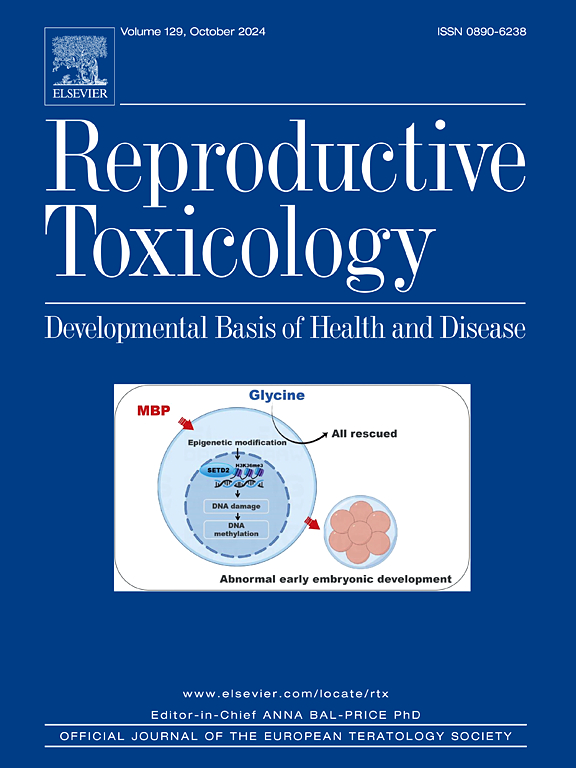Effects of maternal PM2.5 exposure during pregnancy on cardiovascular maldevelopment in rat offspring
IF 2.8
4区 医学
Q2 REPRODUCTIVE BIOLOGY
引用次数: 0
Abstract
Background
Epidemiological studies suggest a link between maternal exposure to PM2.5 during pregnancy and a higher incidence of fetal cardiovascular abnormalities. However, experimental data on the underlying mechanisms remain scarce.
Objective
This study aims to explore the effects of maternal PM2.5 exposure during pregnancy on fetal cardiovascular maldevelopment in a rat model.
Methods
Twenty-eight pregnant rats were divided into control and PM2.5-exposed groups according the exposure doses (N = 7 per group). Rats were administered with PM2.5 suspensions corresponding to 0, 2.6, 5.5, and 11 μg/d, respectively, during gestation. On gestational day 21, neonatal hearts were collected, and levels of cardiac transcription factors (Tbx2, Tbx20, Hand2 and Gata6), MMP9, TN-C, VEGF-A, NF-κB, apoptotic markers (Bax/Bcl-2 ratio), catalase (CAT), and lipid metabolism indicators were measured.
Results
In the 11 μg/d group, the mRNA levels of Tbx2, Tbx20, Hand2, Gata6, MMP9, TN-C and VEGF-A, the protein levels of Tbx2, Hand2, and TN-C, and blood CAT activity were significantly reduced (P < 0.05). Conversely, NF-κB, Bax/Bcl-2, and serum markers of dyslipidemia (TC, TG, LDH, LDL-C/HDL-C) were significantly elevated (P < 0.05). Additionally, TN-C and Hand2 mRNA levels were reduced in the 2.6 μg/d group, and LDH level was increased in the 5.5 μg/d group (P < 0.05).
Conclusions
Maternal PM2.5 exposure during pregnancy is associated with fetal cardiovascular maldevelopments, possibly through the changes of cardiac transcription factors, vascular dysfunction, oxidative stress, apoptosis, and abnormalities of lipid metabolism.
妊娠期母体PM2.5暴露对大鼠子代心血管发育不良的影响
流行病学研究表明,孕妇在怀孕期间暴露于PM2.5与胎儿心血管异常发生率较高之间存在联系。然而,关于潜在机制的实验数据仍然很少。目的探讨妊娠期母体PM2.5暴露对大鼠胎儿心血管发育不良的影响。方法将28只孕鼠按暴露剂量分为对照组和pm2.5暴露组(N = 7 /组)。大鼠妊娠期间分别给予0、2.6、5.5和11 μg/d的PM2.5混悬液。在妊娠第21天采集新生儿心脏,检测心脏转录因子(Tbx2、Tbx20、Hand2、Gata6)、MMP9、TN-C、VEGF-A、NF-κB、凋亡标志物(Bax/Bcl-2比值)、过氧化氢酶(CAT)、脂质代谢指标的水平。结果11 μg/d组Tbx2、Tbx20、Hand2、Gata6、MMP9、TN-C、VEGF-A mRNA水平、Tbx2、Hand2、TN-C蛋白水平及血CAT活性均显著降低(P <; 0.05)。相反,NF-κB、Bax/Bcl-2及血脂异常指标(TC、TG、LDH、LDL-C/HDL-C)显著升高(P <; 0.05)。2.6 μg/d组TN-C和Hand2 mRNA水平降低,5.5 μg/d组LDH水平升高(P <; 0.05)。结论孕妇孕期PM2.5暴露与胎儿心血管发育不良有关,可能通过心脏转录因子的改变、血管功能障碍、氧化应激、细胞凋亡和脂质代谢异常等途径。
本文章由计算机程序翻译,如有差异,请以英文原文为准。
求助全文
约1分钟内获得全文
求助全文
来源期刊

Reproductive toxicology
生物-毒理学
CiteScore
6.50
自引率
3.00%
发文量
131
审稿时长
45 days
期刊介绍:
Drawing from a large number of disciplines, Reproductive Toxicology publishes timely, original research on the influence of chemical and physical agents on reproduction. Written by and for obstetricians, pediatricians, embryologists, teratologists, geneticists, toxicologists, andrologists, and others interested in detecting potential reproductive hazards, the journal is a forum for communication among researchers and practitioners. Articles focus on the application of in vitro, animal and clinical research to the practice of clinical medicine.
All aspects of reproduction are within the scope of Reproductive Toxicology, including the formation and maturation of male and female gametes, sexual function, the events surrounding the fusion of gametes and the development of the fertilized ovum, nourishment and transport of the conceptus within the genital tract, implantation, embryogenesis, intrauterine growth, placentation and placental function, parturition, lactation and neonatal survival. Adverse reproductive effects in males will be considered as significant as adverse effects occurring in females. To provide a balanced presentation of approaches, equal emphasis will be given to clinical and animal or in vitro work. Typical end points that will be studied by contributors include infertility, sexual dysfunction, spontaneous abortion, malformations, abnormal histogenesis, stillbirth, intrauterine growth retardation, prematurity, behavioral abnormalities, and perinatal mortality.
 求助内容:
求助内容: 应助结果提醒方式:
应助结果提醒方式:


